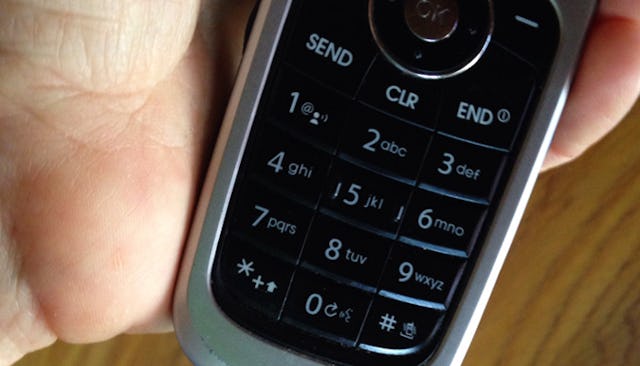What I Learned By Using My Old Flip Phone

To start, my hiatus from smartphone life was based simply in an immediate urgency for phone communication. My smartphone died, and my partner’s mother was in the hospital, so I needed to stay in touch with him.
Effecting what I hoped was just the right balance of desperation and intelligence, I reasoned with the sympathetic young cell phone sales kid, hoping he would be able to replace it without cost, even though I was not eligible for a free new phone for another six months. In the end, I pulled the old flip phone (circa ’09 or ’10) from my purse and said in a motherly manner without room for debate: “It’s okay. Just go ahead and reactivate this one.” Dutifully, the young man did as I requested and wished me well. I hope he still has a job.
Later that week, urgency abated (what remained was my resentment that I had taken care of the phone as best I could and still it died), I explored the options through my carrier for returning to smartphone-hood. Spending $50 to $100 (much less $400 to $500!) for a phone is not part of my worldview, however, whether paid in one massive painful chunk or doled out over 24 mini-painful installments. I dug in my heels and embraced my old friend. “We can do it!” I cried out to my partner, friends and family. “It’s only six months!”
It’s little solace, but I’m not alone in this upgrade limbo. The current average life expectancy for a smartphone in the United States is apparently three months shy of the common 24-month upgrade game. Damage caused by the user contributes to these shortened lives, but dust, heat and bad battery-charging technique are also culprits. Happily for the cell phone companies, Americans average only 18 to 21 months with their phones before trading up to the newest technology, so they have little incentive to improve that life expectancy.
Nonetheless, this upgrade gulf is big business. Indeed, had I not become recalcitrant so early in my research, I could have learned firsthand of the role pre-paid phones play during these periods. According to chat room conversations, you can find a pre-paid phone acceptable to your carrier, then place your defunct phone’s (hopefully still functioning) SIM card into it (or not, depending on which online chat forum you read).
I can’t vouch for any of the above except to say that millions of Americans struggle every day to have and maintain a phone connection due to upgrade limbo, but more so because of the monthly costs of phone ownership. We who have data plans and smartphones are fortunate.
My righteous decision has not been without its challenges. The flip phone’s tiny ear bud plug-in orifice requires a difficult-to-find adapter, which ultimately eluded me. A 10- to 15-minute phone call (pretty long for me at this point) involves switching hands multiple times to give hand, arms and side of head a rest. Radiofrequency radiation may or may not lead to health problems, but it’s hard to ignore the phone getting hot and my hands going a bit numb.
As I well knew going into this period, texting on a flip phone requires patience, which has also often eluded me. “Be there soon” entails 28 clicks plus one more for a period. I try to get punctuation right (so as to avoid “Let’s eat Grandpa” type misunderstandings), but for my sanity, I’ve let go of manual capitalization and complete words. Lamely, I now text things like: “Can you call sally. Thx” or “Sent email. Pls read.”
But the new smartphone moves toward me from a warehouse somewhere on our planet, and I anticipate its arrival with relief and concern. These six months have provided perspective on smartphone as little tyrant, in particular on its tyrannical connection to work. I joked with a friend recently that I was going to set rules before welcoming any such phone back into my life.
After much thought, I’ve chosen one essential rule: No work-related email apps, calendars, beeps or tones on this phone. I never again want to make it easy to “just check in for a minute” (such an insidious lie that is!).
But I say yes to long phone calls and texting with friends, family and, okay, within reason, even colleagues. Yes to taking and exchanging pictures, listening to my favorite community radio station when I work out, and looking up useful and useless information, restaurant locations and definitions of words that I’ve wondered about for ages.
And yes to reflecting regularly on whether or not I’m sticking to my one essential rule, as well as yes to reviewing my behavior to see if other rules have become necessary. Because I want to continue saying yes, yes, yes, to things like sending greeting cards that I fill with handwritten updates and amusing stories and close with an affectionately scripted message: “Best wishes,” “All my love” or, of course, “Talk to you soon!”
This article was originally published on